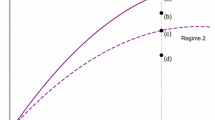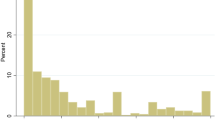Abstract
Estimating International Technology Spillovers Using Technology Flow Matrices. — This paper investigates the impact of international R & D spillovers on sectoral growth patterns in OECD countries. It applies panel regression techniques to a time-series cross-section panel. It arrives at the conclusion that knowledge spillovers are an important contributor to economic growth. The estimation results are applied in the form of a ‘simulation’ of TFP growth per country, splitting (R & D-related) TFP into a component due to domestic R & D and one due to foreign R & D. The results also show that the United States and Germany are the most influential countries in terms of contributions to other countries’ TFP growth.
Zusammenfassung
Die Schätzung internationaler Technologie-Spillover mit Hilfe von Technologiefluß-Matrizen. — Der Verfasser untersucht die Auswirkung internationaler Spillover von Forschung und Entwicklung (R & D) auf die sektoralen Wachstumsmuster in OECD-Ländern. Er wendet Panel-Regressionstechniken auf ein Zeitreihen-Querschnitts-Panel an. Dabei kommt er zu dem Schluß, daß die Spillover von Kenntnissen wesentlich zum wirtschaftlichen Wachstum beitragen. Die Schätzer-gebnisse werden in Form einer “Simulation” des Wachstums der totalen Faktorproduktivität (TFP) pro Land angewandt, wobei die (R & D-relevante) TFP aufgespalten wird in eine Komponente, die durch heimische Forschung und Entwicklung (R & D) verursacht worden ist, und eine, die auf ausländischer R & D basiert. Die Ergebnisse zeigen, daß die Vereinigten Staaten und Deutschland die einflußreichsten Länder sind im Hinblick auf den Beitrag zum Wachstum der TFP anderer Länder.
Similar content being viewed by others
References
Abramovitz, M. (1979). Rapid Growth Potential and Its Realization: The Experience of the Capitalist Economies in the Postwar Period. In E. Malinvaud (ed.),Economic Growth and Resources, Vol. I. London: Macmillan.
—1994). The Origins of the Postwar Catch-Up and Convergence Boom. In J. Fager-berg, B. Verspagen, and N. von Tunzelmann (eds.),The Dynamics of Technology, Trade and Growth. Aldershot: Edward Elgar.
Banerjee, A., J. Dolado, J. W. Galbraith, and D. F. Hendry (1993).Co-Integration, Error-Correction, and the Econometric Analysis of Non-Stationary Data. Oxford: Oxford University Press.
Coe, D. T., and E. Helpman (1995). International R & D Spillovers.European Economic Review 39 (5): 859–887.
Cohen, W. M., and D. A. Levinthal (1989). Innovation and Learning: The Two Faces of R & D.Economic Journal 99 (September): 569–596.
Denison, E. F. (1967).Why Growth Rates Differ: Postwar Experience in Nine Western Countries. Washington, D. C.: The Brookings Institution.
Fagerberg, J. (1994). Technology and International Differences in Growth Rates.Journal of Economic Literature 32(3): 1147–1175.
Gittleman, M., and E. N. Wolff (1995). R & D Activity and Cross-Country Growth Comparisons.Cambridge Journal of Economics 19 (1): 189–207.
Griliches, Z. (1979). Issues in Assessing the Contribution of Research and Development to Productivity Growth.Bell Journal of Economics 10(1): 92–116.
(1992). The Search for R & D Spillovers.Scandinavian Journal of Economics 94 (Suppl.):S29-S47.
Griliches, Z., and J. Mairesse (1984). Productivity and R & D at the Firm Level. In Z. Griliches (ed.),R & D, Patents and Productivity. Chicago: University of Chicago Press.
Grossman, G. M., and E. Helpman (1991).Innovation and Growth in the Global Economy. Cambridge, Mass: MIT Press.
Grupp, H. (1996). Spillover Effects and the Science Base of Innovations Reconsidered: An Empirical Approach.Journal of Evolutionary Economics 6(2): 175–197.
Jaffe, A. B. (1986). Technological Opportunity and Spillovers of R & D: Evidence from Firms’ Patents, Profits, and Market Value.American Economic Review 76 (5): 984–1001.
Lichtenberg, F., and B. van Pottelsberghe de la Potterie (1996). International R & D Spillovers: A Re-Examination. NBER Working Paper 5668. Cambridge, Mass.
Los, B., and B. Verspagen (1996). R & D Spillovers and Productivity: Evidence from U.S. Manufacturing Microdata. MERIT Research Memorandum 96-007. University of Limburg. Maastricht.
Lundvall, B.-A. (ed.) (1992).National Systems of Innovation: An Analytical Framework. London: Pinter.
Mairesse, J., and M. Sassenou (1991). R & D and Productivity: A Survey of Econometric Studies at the Firm Level.STI Review 8:9–43.
Mohnen, P. (1995). Some Estimates of International R & D Spillovers. Paper presented at the Tip Conference “The Emerging Knowledge-based Society”, September 21–22, Vienna.
Nadiri, M. I. (1993). Innovations and Technological Spillovers. NBER Working Paper 4423. Cambridge, Mass.
Nadiri, M. I., and S. Kim (1996). International R & D Spillovers, Trade and Productivity in Major OECD Countries. Economic Research Reports 96-35. C. V. StanCenter for Applied Economics, New York.
Park, W. G. (1995). International R & D Spillovers and OECD Economic Growth.Economic Inquiry 33 (October): 571–591.
Putnam, J., and R. E. Evenson (1994). Inter-Sectoral Technology Flows: Estimates from a Patent Concordance with an Application to Italy. Yale University, mimeo.
Romer, P. M. (1990). Endogenous Technological Change.Journal of Political Economy 98(5, part 2): S71 -S102.
Scherer, F. M. (1982). Inter-Industry Technology Flows and Productivity Measurement.Review of Economics and Statistics 64 (4): 627–634.
Terleckyj, N. E. (1974). Effects of R & D on the Productivity Growth of Industries: An Exploratory Study. Report 140. National Planning Association, Washington, D.C.
Van Meijl, H. (1995). Endogenous Technological Change: The Case of Information Technology. PhD. Thesis. University of Limburg, Maastricht.
Verspagen, B. (1994). Technology and Growth: The Complex Dynamics of Convergence and Divergence. In G. Silverberg and L. Soete (eds.),The Economics of Growth and Technical Change. Aldershot: Edward Elgar.
— (1995). R & D and Productivity: A Broad Cross-Section Cross-Country Look.Journal of Productivity Analysis 6(2): 117–135.
— (1997). Measuring Inter-Sectoral Technology Spillovers: Estimates from the European and US Patent Office Databases.Economic Systems Research 9(l):49–67.




